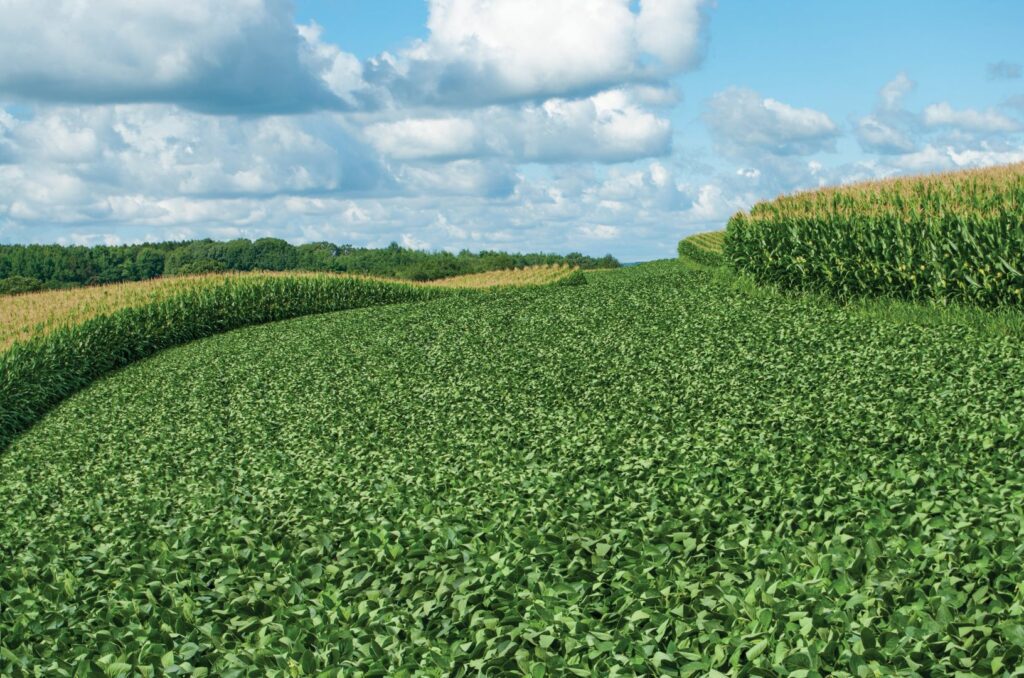Phil Schwantz is a third-generation farmer who’s proud to be the steward of his grandfathers’ farmland. He lives on the farmstead where his paternal grandfather and father farmed and rents land from his aunt that was once farmed by his maternal grandfather.
He also feels fortunate to be working with Midwestern BioAg on a program that has created “an explosion” of earthworms on his 500 acres of tillable farmland. A leading indicator of soil health, earthworm activity can increase soil infiltration and improve water-holding capacity, help breakdown plant residues, and stimulate microbial activity, all major drivers of plant growth and productivity. Working with BioAg consultant Mike Lovlien, Schwantz focuses on improving his soil structure and providing his crops with what they need to produce top yields.
Schwantz grew up knowing the land and has been farming it since he was a young man, first with his dad and then on his own after graduating from high school in the late 1970s.
He says he’s always been competitive when it comes to farming. “If I get 200 bushels, I think we should go for 210,” he said. In his years of farming and improving the land, he has ratcheted up production incrementally. “Back in ’78, if you had 150 bushels per acre, that was considered good.”
When he began farming after high school, the county-program yield for his land was in the range of 114 to 120 bushels of corn per acre. Over the years, he’s switched from wide rows to narrow rows and went with a mostly no-till system. His ten-year average for corn production now stands at 205 bushels per acre, almost a 100 percent increase over the past 30 years.
Building Soil Capacity
Schwantz started working with Midwestern BioAg in the early 1990s after learning more about the company from a consultant. “I was always looking for something else and they were talking a little different story. I was willing to try. If we saw results then it was something we’d stick with.” Schwantz says he sees those results each year — more production per acre and less unit inputs.
Schwantz’s land has increased in organic matter and in cation exchange capacity (CEC), which is a measure of the nutrient-holding ability of the soil. “There’s no right or wrong CEC, but you need to know what it is to recommend the right fertilizer application rates,” says Lovlien.
In fall 2013, Schwantz worked with BioAg to grid sample his acres to identify nutrient deficiencies in specific locations. Using this data, he can now implement variable rate fertilizer application on his farm for optimum nutrient efficiency.
“Organic matter is increasing, CEC is rising, and yield is rising. Something’s got to be working in sync,” says Schwantz. He likes that he and Lovlien go out into the fields with a spade to look for soil life, a sign of healthy, productive ground.
Season-Long Fertility
Schwantz bulk spreads Midwestern BioAg’s dry fertilizer before planting each spring. “Last year, Phil applied 420 pounds per acre of 15-12-12-7S with high traces,” said Lovlien. “Like all our fertilizers, Phil’s blend contains high quality ingredients like ESN® and ammonium sulfate for season-long nutrient availability.”
Midwestern BioAg’s dry blends supply both NPK and a balanced supply of secondary nutrients and trace minerals. “Because yields can be limited by deficiencies of any nutrient,” said Lovlien, “overcoming yield-limiting factors on the farm starts with addressing nutrient deficiencies in the soil.”
While planting corn, Schwantz applies BioAg’s liquid carbon-based fertilizer (L-CBF) 10-14-1 at 5 gallons per acre as a pop-up starter. Schwantz has seen great results with the product and plans to apply it for the third year this spring.
About three to four days following planting, Schwantz applies liquid 28% with herbicide. “Phil applies 28% at 20 gallons per acre, or 60 units,” said Lovlien. “His dry fertilizer supplies 63 units of nitrogen. That’s 123 units of purchased nitrogen per acre — about 163 units total if we count the 40-unit credit from soybeans the previous year.”
In past years, Schwantz has planted oats as a cover crop following corn and soybeans to scavenge nutrients. “2015 was a great year for cover crops,” said Lovlien. “This fall, Phil plans to aerial seed ryegrass and radish into standing corn.”
Looking Ahead
In addition to farming his own land, Schwantz also custom-plants corn for others. He recently upgraded his planter with liquid application equipment so he can plant more acres per fill than with dry starter in the past. The planter is GPS-equipped, and Lovlien and Schwantz plan to use that function to incorporate information from grid samples. Lovlien notes that by intensively sampling fields, Schwantz can better target where fertilizer is needed and in what amounts.
“I want to leave the soil in better shape than when I started. I think that’s what a farmer should do.”
Now that there isn’t manure to haul on his farm every day, as there was in the days when he was dairy farming, Schwantz looks for different ways to manage his land. “I try to primarily no-till, which gives me more options.”
A dairy farmer until 2002, Schwantz sold his 65-cow herd when he felt he was at a crossroads of investing significant money in dairy facilities or doing something else. He decided to raise heifers for another farmer until the use of sexed semen resulted in too many heifers for his facilities. Again he was at a crossroads, trying to decide if he should invest in more livestock facilities or instead raise his own steers. Today, Schwantz rents his facilities to a beef producer.
For now, Schwantz is concentrating on his land. “I want to leave the soil in better shape than when I started. I think that’s what a farmer should do.”
____
Jan Shepel has over 25 years of ag journalism experience and lives in southwestern Wisconsin.

